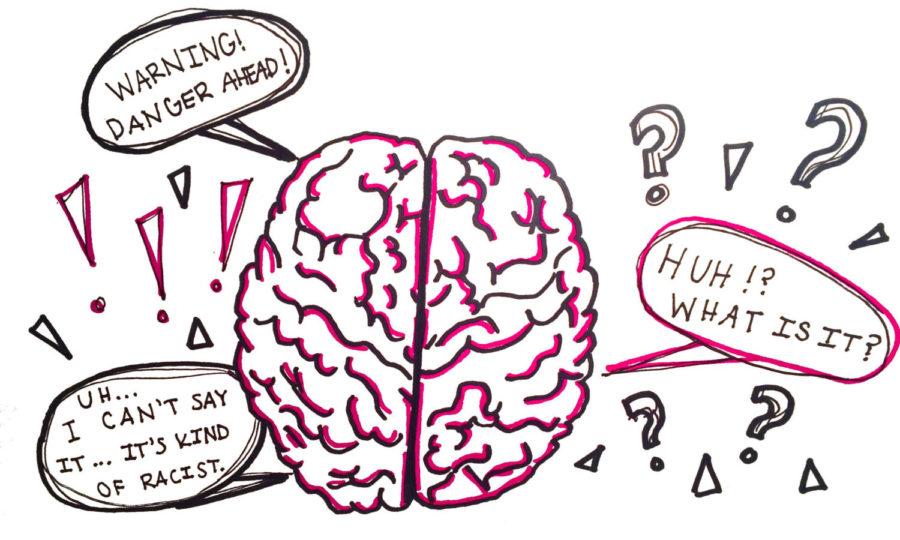Imagine you’re walking down Forbes Avenue one afternoon, and suddenly a man wearing a ski mask grabs your backpack and sprints away. You call the police immediately, and although the backpack is nowhere to be found, they’ve arrested two men who match your description of the perpetrator. You’re taken into the police station to assist in identifying him — one of the men is white, the other black. Perhaps you wouldn’t expect yourself to naturally feel inclined to thinking the black man is guilty — but statistically, you probably would.
We’ve all probably experienced this phenomenon on one street corner or another. It is known as implicit bias — harboring unconscious biases or expectations, regardless of ill will or any self-aware prejudices.
Our unconscious train of thought cannot be controlled, so these beliefs are not our fault. Having implicit biases does not make us bad people, and doesn’t make us explicitly racist. But a society motivated by uncontrolled, unconscious beliefs is not a very effective or a very judicious one.
Implicit racism holds many dangerous implications within society, including racial profiling, injustice for minorities within the court systems and employment practices. Professionals in our community are only human, after all. They are just as likely to succumb to these beliefs.
These instances can cause a great deal of emotional and political dissatisfaction from victims of implicit racism, leading to social and political backlash.
Luckily, there may be a solution to the problem. Several different studies show that just being more informed on biases reduces the extent to which they come into play in one’s life. Simply reading about it is a step toward reducing or eliminating your biases altogether.
Being self-aware of our feelings and beliefs is key to understanding our biases — only then can we move toward honest social progress. This allows us to make more just, informed decisions and avoid decisions based on emotion that results from blindly following implicit biases. One of the best, most effective ways to increase our awareness is to read and understand a few important social experiments and studies.
The implicit association test is one of the most popular tests in studying these biases — it’s designed to measure the strength between concepts and evaluations. This is important because it eliminates the dangers of social desirability biases that can occur in people’s core beliefs, specifically racism. Social desirability biases occur when respondents change their answer to a question to adhere to social norms.
However, with the IAT, subjects cannot lie or alter their responses because they fear judgment from the experimenters or society. Since the test employs subjects’ unconscious beliefs by handing individuals tasks that ask respondents to immediately categorize stimuli into groups, the response time between the categorization of one group and another shows the presence of implicit biases because the test only employs one’s innate responses. There’s simply no time to think — the responses are instinctual.
Another study by the West Virginia Law Review explored the implicit racism within the legal system, demonstrating the ways these unconscious biases can push us to make unjust decisions in determining whether someone is guilty of a crime.
In this study, researchers tested and found that when study participants were shown images of black and white perpetrators, they found accompanying evidence of the mock crime to be supportive of a guilty verdict for the black man. The jurors were unintentionally biased in their evaluation of evidence. If more people were aware of these tendencies, the unfair treatment of racial minorities in the justice system could finally improve.
Implicit racism has long plagued the American justice system, and a 2014 study by The Sentencing Project revealed just how rampant the over-association between crime and black people is. In a 2010 survey during the study, researchers found that white Americans overestimated the number of crimes committed by black people by 20 to 30 percent.
Besides these social studies, more physical experiments found that the bias likely originates in the brain by using fMRIs — functional magnetic resonance imaging. These fMRIs show that when white subjects are shown unknown white faces and unknown black faces, the amygdala — which is associated with emotions like fear — is activated only when shown unknown black faces.
Fixing these thoughts, which have likely been ingrained into all of us from an early age thanks to actions and observations both personal and from the media, is hard work. It requires digging deep and constantly reminding yourself that there’s more to a person than what anyone could conceive from the outside.
Becoming aware of your implicit biases may not create huge, noticeable changes in you, but you may not be so quick to point an accusing finger at those who’ve done nothing wrong.
Vaibhavi primarily writes about social justice for The Pitt News. Write to Vaibhavi at [email protected].



